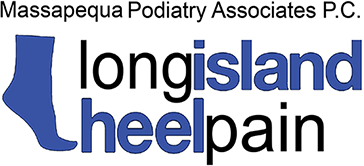Inflammation of the Achilles tendon, which connects the calf muscles to the heel bone, can result in a condition known as Achilles tendinitis. It's a common issue, particularly among athletes and individuals who engage in repetitive activities that stress the Achilles tendon. This is a common issue we diagnose and treat at Massapequa Podiatry Associates.
Six Symptoms of Achilles Tendinitis
 Both insertional and non-insertional Achilles tendinitis have similar symptoms. Understanding the symptoms is crucial for early diagnosis and effective management.
Both insertional and non-insertional Achilles tendinitis have similar symptoms. Understanding the symptoms is crucial for early diagnosis and effective management.
1. Pain and Stiffness in the Heel
Achilles tendinitis often begins with mild pain and stiffness in the back of the heel. The pain and stiffness may be worse after physical activity. Pain levels often spike during activities involving running, jumping, or walking, severely limiting a person's ability to engage in their usual activities.
Additionally, many people with Achilles tendinitis report experiencing significant pain and stiffness in the morning when they first get out of bed. The tendon may be tight and painful upon initial movement. The pain and stiffness can gradually worsen over time if left untreated.2. Reduced Range of Motion
As the condition progresses, individuals may experience a reduced range of motion in the ankle and foot. This limitation can make it challenging to perform activities that require ankle flexibility, such as pointing the toes or bending the foot upward.
3. Tenderness and Swelling
The affected area of the Achilles tendon may become tender to the touch. Swelling can also occur, causing a noticeable lump or bump in the tendon. This is likely to be present all the time but worsen throughout the day or with increased activity.
4. Redness and Warmth
In severe cases of Achilles tendinitis, the affected area may become red and warm to the touch. This can indicate an increased level of inflammation and should be promptly evaluated by a health care provider.
5. Tendon Thickening
In some cases, individuals with Achilles tendinitis may notice thickening or enlargement of the affected tendon. This can often be felt or seen as a lump along the back of the ankle. It's a sign that the tendon is changing due to inflammation and damage.
6. Crepitus
Crepitus is a term used to describe a crackling or grating sound when the Achilles tendon is moved. It can be a sign of degeneration within the tendon and should be assessed by a medical professional.
It's important to note that if you experience any of these symptoms, seeking professional advice from a podiatrist is essential for an accurate diagnosis and appropriate treatment. Early intervention can help prevent the condition from worsening and improve your chances of a full recovery.
At-Home Treatment
You may try to alleviate Achilles tendinitis pain and discomfort at home by doing one or more of the following:
- Rest
- Over-the-counter anti-inflammatory medication
- Ice
- Stretching
Professional Treatment for Achilles Tendinitis
The at-home treatments described above address Achilles tendinitis symptoms. However, a podiatrist can treat the underlying cause of your condition. Seeing a podiatrist as soon as possible:- Allows for rapid diagnosis and treatment
- May prevent the tendon from tearing
- Addresses pain before it becomes worse
- Could help you avoid surgery
Tenex
Tenex uses vibrations to break down and remove damaged tendon tissue without impacting the surrounding healthy tissue.
Extracorporeal Shockwave Therapy (ESWT)
ESWT is a form of regenerative medicine that sends high-energy pressure waves into an area with tissue damage, which leads to increased blood flow, break down of calcifications, and accelerated tissue repair.
MLS Laser Therapy
MLS laser therapy is a painless, non-invasive method of relieving foot pain related to Achilles tendinitis.
Platelet-Rich Plasma Therapy (PRP)
PRP is a technique that uses a patient's own blood and cells to accelerate their healing. This is an approach that is used after more traditional methods have failed.
Surgery
There are a couple of different surgical procedures that can be performed for Achilles tendinitis. However, at Massapequa Podiatry Associates, we consider these a last resort. They are generally only used if the tendon has torn or non-surgical treatment has failed to address the problem.

